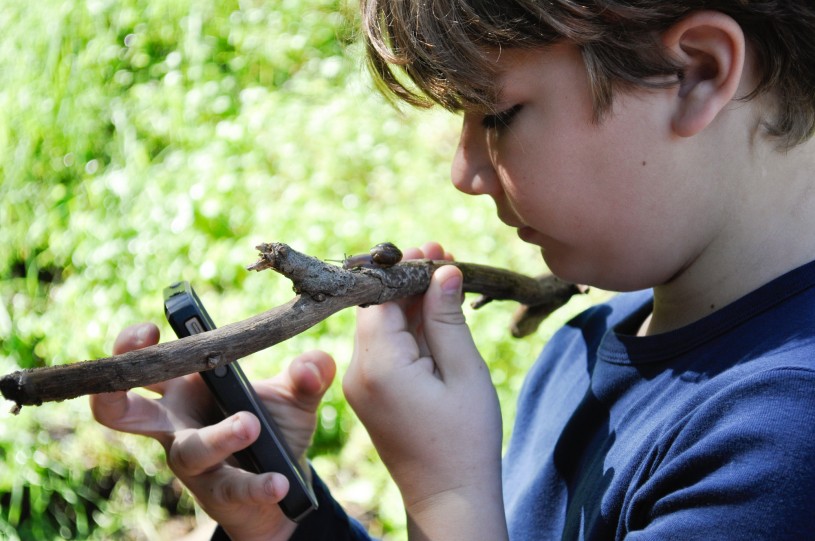Los Angeles, CA (April 8, 2024) — As community science initiatives build momentum around the world, this year’s ninth annual City Nature Challenge (CNC) will take place in more than 675 cities across seven continents. Kicking off Friday, April 26 at 12:01 am in each time zone, CNC runs through 11:59 pm on Monday, April 29. The global event calls on current and aspiring community scientists, nature and science fans, and people of all ages and education backgrounds to observe and submit pictures of wild plants, animals, and fungi using free mobile apps like iNaturalist. From Tuesday, April 30 through Sunday, May 5, the online community will collaborate to identify species that were photographed during the Challenge, with the total number of observations and highlights from around the world announced on Monday, May 6.
As scientists increasingly rely on community-generated data, it is more important and impactful than ever to document nature observations on community science platforms like iNaturalist. From a study on bees in urban environments to a revision of the global biogeography of plants, 890 studies were published using iNaturalist data in 2023. This data helps policymakers make informed conservation decisions that enable humans to coexist with the wildlife around them and view themselves as a part of, not apart from, nature.
After launching the first-ever CNC in 2016, the Natural History Museums of Los Angeles County (NHMLAC) and San Francisco’s California Academy of Sciences (CAS) are hosting their ninth effort. Last year’s four-day Challenge included over 66,000 participants across more than 450 cities around the world to observe and submit pictures of wildlife they encountered. Participants added over 1.87 million observations of nature to iNaturalist, and scientists continue to use these data to understand and conserve urban wildlife.
“With more cities taking part than ever before, participants in this year’s challenge will be able to collect unprecedented amounts of data in urbanized areas,” says Lila Higgins, Co-Senior Manager, Community Science for NHMLAC. “This data is more important than ever, as we are working to protect biodiversity both locally here in Los Angeles and in cities all over the globe.”
Notably, the number of participating cities grew from 450 in 2023 to more than 675 in 2024 — one of the biggest jumps in CNC history. This significant uptick is the result of a network of organizers in India who are bringing 206 new projects to the global effort.
“Last year, India’s 20 participating cities had a much larger turnout than we expected, so it was clear there was a real need for community events like these,” says Ram Dayal Vaishnav, Education Director at CitizenScience.Asia and CNC organizer for Hyderabad, India. “Our goal was to have at least one participating city in every state and union territory of India, but as we recruited more and more people, we found there was an overwhelming interest from every corner of the country. While we’re looking forward to our biggest City Nature Challenge yet, wildlife in India is best observed during our monsoon season, which begins in June. We hope to continue this momentum well after the Challenge weekend, and encourage communities—especially younger generations who are more eager to use iNaturalist—to explore their local nature and upload their observations throughout the year.”
How to Participate
For both budding and veteran community scientists, participating is easy:
- Find wildlife. It can be any wild plant, animal, fungi, slime mold, or any other evidence of life (scat, fur, tracks, shells, carcasses) found in your participating city. Check out this guide for tips on finding the surprisingly abundant biodiversity in and around your own home.
- Take pictures and/or sound recordings of what you find using iNaturalist or your city’s chosen platform.
- Learn more on iNaturalist as your observations get identified!
2023 Highlights
Scientists can’t be everywhere at once, so without community observations, they’d miss some incredible finds. From an Indo-Pacific humpback dolphin in Hong Kong to a giant electric ray with albinism or leucism near Mexico’s Socorro Island, there were over 2,500 observations of rare and endangered species during last year’s CNC. In La Paz, Bolivia—which tallied the highest number of observations for the second consecutive year—an observation of a small orchid previously only recorded in the nearby city of Cochabamba provided critical information about the plant’s range. In Ukraine, one iNaturalist user documented the first observation of the palaearctic backspined meshweaver spider in the country. And a recently caught bull shark in a local fish market in Thailand served as a reminder of the dangers of overfishing. Many other endangered, endemic, or data deficient species were recorded during the CNC, an influx of information that gives scientists, educators, urban planners, and policymakers insight into the biodiversity of urban locales throughout the world.
See participating cities and learn more about the City Nature Challenge.
iNaturalist
Signing up is easy and free. Visit inaturalist.org from your browser, or download iNaturalist from the Apple App Store or Google Play Store.
Social Media
#CityNatureChallenge
Twitter handle: @citnatchallenge
Instagram: @citnatchallenge
About the Natural History Museums of Los Angeles County
The Natural History Museums of Los Angeles County (NHMLAC) include the Natural History Museum, La Brea Tar Pits, and the William S. Hart Museum. They operate under the collective vision to inspire wonder, discovery, and responsibility for our natural and cultural worlds. The museums hold one of the world’s most extensive and valuable collections of natural and cultural history—more than 35 million objects. Using these collections for groundbreaking scientific and historical research, the museums also incorporate them into on- and offsite nature and culture exploration in L.A. neighborhoods, and a slate of community science programs—creating indoor-outdoor visitor experiences that explore the past, present, and future. Visit NHMLAC.ORG for adventure, education, and entertainment opportunities.
The Natural History Museum of Los Angeles County is located at 900 Exposition Blvd., Los Angeles, CA 90007.
About the California Academy of Sciences
The California Academy of Sciences is a renowned scientific and educational institution with a mission to regenerate the natural world through science, learning, and collaboration. Based in San Francisco’s Golden Gate Park, it is home to a world-class aquarium, planetarium, and natural history museum, as well as innovative programs in scientific research and environmental education—all under one living roof. Museum hours are 9:30 am – 5:00 pm Monday – Saturday, and 11:00 am – 5:00 pm on Sunday. Admission includes all exhibits, programs, and shows. For daily ticket prices, please visit www.calacademy.org or call (415) 379-8000 for more information.
Media Contacts
Amy Hood
213-763-3532
ahood@nhm.org
Josh Chesler
213-763-3580
jchesler@nhm.org

